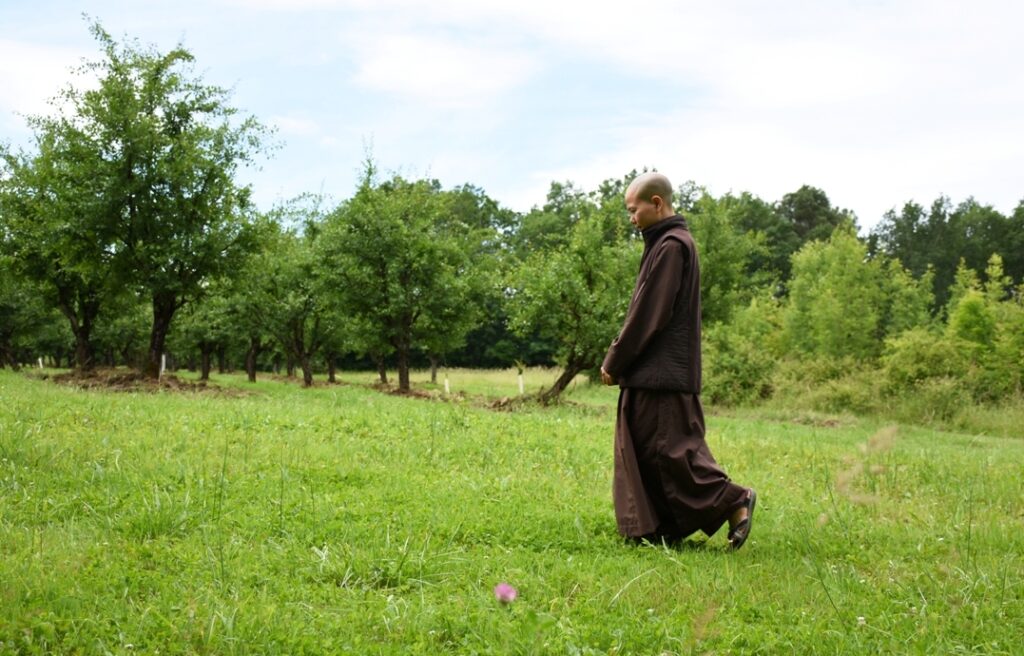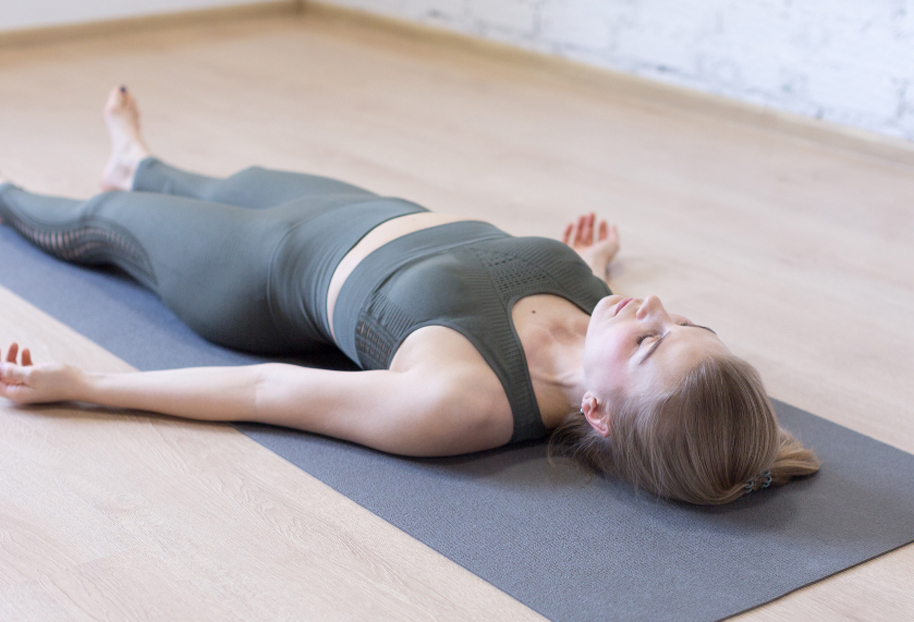Meditation is not just sitting silently for a period of time. It marks the beginning of a journey deep into the mind. Through exploring the depths of the soul, meditation helps us understand our true desires; and develop an understanding of ourselves, our values. When starting out, one may encounter a myriad of meditation methods and be unsure which to choose.
To address this issue, LotusBuddhas introduces eight prominent techniques like beacons of light, illuminating the path for beginners. These methods, steeped in tradition yet astonishingly accessible, offer a harmonious blend of simplicity and depth, serving as ideal vehicles to introduce newcomers to the world of inner contemplation and mindfulness.
What is Meditation?
Meditation, as defined by the American Psychological Association, is a practice of deep reflection or contemplation aimed at fostering focused attention and awareness of the self and the surrounding world.
In Buddhism, meditation serves as a tool for transforming consciousness through calming the mind and focusing attention, enabling individuals to attain self-realization and profound understanding of the world around them.
Regardless of the perspective, meditation is fundamentally an engagement with the mind, encompassing activities such as concentration, relaxation, contemplation, or expressing thoughts. Historically, meditation has been associated with spiritual and religious rituals. However, from a scientific standpoint, it is recognized as an effective method for promoting relaxation, reducing stress, and alleviating symptoms like high blood pressure, pain, and insomnia, thereby supporting enhanced physical and mental health.
Meditation Techniques for Beginners
1. Mindfulness Meditation
Mindfulness Meditation, rooted in ancient Buddhist traditions and now a cornerstone in contemporary psychological practices, is a methodical approach to cultivate heightened awareness of the present moment. It underscores the significance of anchoring one’s attention to current experiences, emphasizing observation over judgment, and acceptance over reaction.
At its core, Mindfulness Meditation encourages practitioners to observe their thoughts, emotions, and bodily sensations as they unfold, without attempting to change, judge or engage with them. Instead, individuals learn to witness these phenomena as transient events in the mind, fostering a deeper understanding of their transient nature.
Several reasons make Mindfulness Meditation particularly suitable for beginners:
- Simplicity: Unlike some meditation techniques which may require intricate visualization or mantra repetition, Mindfulness Meditation is straightforward. One merely has to focus on the present, be it through the breath or sensory experiences.
- Flexibility: It doesn’t mandate a specific posture, time, or setting. Whether seated, lying down, or even walking, the practice can be integrated into various daily activities.
- Tangible benefits: Even short-term practice can yield discernible benefits. Research has documented its effectiveness in reducing stress, improving concentration, and enhancing emotional well-being, making the initial experiences rewarding for beginners.
- Foundation for advanced techniques: Mastering mindfulness provides a solid foundation for delving into more advanced meditation techniques. It cultivates essential skills like concentration, awareness and non-attachment.
- Support and resources: Given its popularity in the West, numerous resources, ranging from mobile apps to workshops, are available to guide beginners through the initial stages of the practice.
Mindfulness Meditation offers an accessible, adaptable, and effective entry point for those new to meditation. Its emphasis on present-moment awareness resonates universally, making it a favored choice for individuals seeking mental clarity and emotional balance.
2. Body Scan Meditation
Body Scan Meditation, a foundational element of many meditative practices and particularly emphasized in the Mindfulness-Based Stress Reduction (MBSR) program developed by Dr. Jon Kabat-Zinn, is a systematic process of directing attention to different parts of the body in sequence. This technique serves as a bridge between the physical and mental domains, cultivating a heightened awareness of bodily sensations, whether they be tension, relaxation, warmth or any other perceivable feeling.
During a Body Scan Meditation, participants are guided, either by a teacher, recording, or their own mental process, to shift their focus progressively through the body, often commencing at the toes and culminating at the crown of the head. Throughout this progression, the aim is not to change or judge the sensations but merely to observe and acknowledge them.
Several factors underscore the appropriateness of Body Scan Meditation for those embarking on their meditative journey:
- Structured approach: For novices, the defined sequence – moving from one body part to another – offers a clear structure that can be easier to follow than more abstract meditation practices.
- Immediate feedback: The tangible nature of bodily sensations provides immediate feedback. Practitioners can readily discern feelings like tension or relaxation, which can be gratifying and affirming for beginners.
- Grounding effect: By anchoring awareness in the physicality of the body, this method can be particularly grounding, helping individuals, especially those whose minds tend to wander, to stay present.
- Enhanced mind-body connection: For those new to meditation, the Body Scan can foster a more profound connection between mental processes and physical sensations, laying a foundation for deeper introspective practices in the future.
- Applicability: The skills cultivated in Body Scan Meditation can be applied in daily life. For instance, recognizing bodily tension in stressful situations can prompt relaxation techniques, thereby fostering better stress management.
Body Scan Meditation with its structured, tangible, and grounding nature, presents an excellent entry point for those unacquainted with meditative practices.
3. Loving-Kindness Meditation (Metta)
Loving-Kindness Meditation, traditionally referred to as “Metta” in the Pali language and deeply embedded in Buddhist practices, is a methodical cultivation of benevolence, compassion, and unconditional goodwill towards oneself and others. The practice centers on the repetitive mental recitation of specific phrases that express wishes for well-being, happiness and freedom from suffering.
During Metta meditation, practitioners typically commence with directing loving-kindness towards themselves, progressing to loved ones, acquaintances, indifferent individuals, and even those with whom they may have conflicts. The ultimate aim is to cultivate an expansive, boundless love that encompasses all sentient beings.
Several facets make Loving-Kindness Meditation (Metta) especially amenable to beginners:
- Emotionally resonant: The universal theme of love and well-being is emotionally resonant, making it relatively easy for beginners to connect with the practice on a profound level.
- Structured format: The phased approach – starting from oneself and moving outwards to all beings – provides a clear and structured path for practitioners, aiding in maintaining focus and direction.
- Immediate psychological benefits: Preliminary engagement with Metta can often yield palpable benefits, such as reduced feelings of animosity, heightened states of happiness, and an enhanced sense of interconnectedness, providing immediate gratification and motivation for continued practice.
- Counteracting negative patterns: For those new to meditation and grappling with self-critical or negative thought patterns, Metta offers a nurturing antidote by fostering self-compassion and a positive mindset.
- Extensive accessibility: Given its universal appeal, there exists a wealth of resources, from guided sessions to written literature, that can facilitate a beginner’s immersion into the practice.
- Foundational for deeper practices: As practitioners become adept at Metta, the cultivated compassion and benevolence form a robust foundation for delving into more advanced meditative techniques, particularly those that navigate the intricacies of human emotions and relationships.
Loving-Kindness Meditation (Metta) stands as an exemplary starting point for individuals initiating their journey into the realm of meditation. Its power to engender both inner peace and external harmony makes it an indispensable tool in any meditative repertoire.
4. Guided Meditation
Guided Meditation, a prevalent modality in contemporary meditative practices, is characterized by the presence of a guiding voice – either in person or via recorded media – that directs the participant’s journey through the meditative process. This guidance can encompass a spectrum of themes, ranging from relaxation and breath-awareness to intricate visualizations or journeys through imagined landscapes.
The salient features and mechanics of Guided Meditation are delineated as follows:
- Narrative direction: The guide or narrator provides explicit instructions, weaving a narrative that the practitioner follows, thereby steering the flow and depth of the meditation.
- Thematic versatility: The topics and themes of Guided Meditation can be varied, allowing for sessions tailored to specific goals such as stress reduction, sleep enhancement, or emotional healing.
- Auditory engagement: Beyond the spoken instructions, many guided sessions integrate ambient music or nature sounds, further enhancing the immersive experience.
Several factors converge to make Guided Meditation particularly advantageous for those at the threshold of their meditative exploration:
- External focal point: The guiding voice serves as an external anchor, assisting beginners in maintaining their concentration, which can often waver in self-led sessions.
- Structured progression: The pre-defined path eliminates guesswork and ensures a systematic progression, reducing potential feelings of uncertainty or inadequacy common amongst novices.
- Diverse exploration: With an array of available themes, beginners can sample various meditation styles and objectives, providing a holistic introduction to the domain.
- Immediate accessibility: The proliferation of digital platforms, apps, and online resources means that high-quality guided sessions are readily available, allowing novices to embark on their practice with minimal barriers to entry.
- Reduced cognitive load: For those unacquainted with meditation, formulating a self-guided approach can be daunting. Guided Meditation alleviates this by providing clear directives, allowing the beginner to focus solely on their experience.
- Enhanced confidence: Achieving tangible results, be it relaxation or visualization, under expert guidance can bolster a beginner’s confidence, facilitating a more consistent and prolonged engagement with meditation.
Guided Meditation, with its ability to provide both immediate benefits and a broad introduction to different meditation styles, makes it an invaluable tool for beginners.
5. Mantra Meditation
Mantra Meditation, deeply embedded within the tapestry of Hindu, Buddhist, and other spiritual traditions, is predicated on the repetitive vocalization or mental intonation of a specific word, phrase, or sound, termed a “mantra.” This mantra serves as both a focal point and a vibrational tool, with the intent of facilitating deepened states of consciousness and spiritual ascension.
The mechanics and attributes of Mantra Meditation can be delineated as follows:
- Mantric resonance: The chosen mantra, whether it be a sacred word like “Om” or a specific phrase, is believed to possess a unique vibrational frequency that can influence the practitioner’s internal energy and consciousness.
- Sustained repetition: The continuous repetition, either aloud or internally, is designed to draw the practitioner away from extraneous thoughts and immerse them fully in the present moment.
- Convergence of sound and silence: While the mantra’s vocalization introduces a sound element, periods of silence that ensue can lead to profound introspection and tranquility.
Several attributes render Mantra Meditation particularly conducive for those initiating their journey into meditative practices:
- Cognitive anchor: The mantra acts as a steadfast cognitive anchor, assisting beginners in navigating the oft-tumultuous waters of a wandering mind, thereby facilitating sustained concentration.
- Simplicity of practice: While profound in its implications, the actual practice of Mantra Meditation is straightforward. The repetitive nature reduces cognitive load, making it approachable for novices.
- Cultural and philosophical richness: For those inclined towards spiritual or philosophical exploration, delving into the meanings and origins of specific mantras can add depth and significance to the practice.
- Modularity: Mantra Meditation is adaptable. It can be practiced in isolation, incorporated into other forms of meditation, or even melded with daily activities, offering flexibility to beginners.
- Audible feedback: When vocalized, the mantra provides an auditory feedback mechanism. This tangible element can be reassuring for beginners, offering an immediate sense of engagement and progression.
- Enhanced neural coherence: Contemporary research suggests that the rhythmic repetition inherent to Mantra Meditation can foster neural coherence and altered states of consciousness, providing palpable benefits even in the early stages of practice.
Mantra Meditation with harmonious blend of simplicity and profundity, emerges as a sterling choice for those newly introduced to the meditation realm. Its dual capacity to anchor the mind and elevate consciousness makes it both accessible and transformative, positioning it as a cornerstone in the meditation spectrum.
6. Walking Meditation
Walking Meditation, distinct from the more commonly visualized seated meditation practices, melds the deliberate act of walking with mindful awareness. Rooted in various ancient traditions, including Buddhism and Taoism, it transforms a daily, mundane activity into a profound practice of introspection and presence.
A synthesis of the core principles of Walking Meditation can be expounded as follows:
- Integrated movement: Unlike static forms of meditation, Walking Meditation integrates physical movement, rhythmically aligning steps with breathing or specific mindfulness cues.
- Environmental engagement: The practice is often conducted outdoors, fostering an acute awareness of the surrounding environment – from the sensation of ground beneath the feet to the subtleties of changing sceneries and ambient sounds.
- Paced progression: The walking speed in this practice is generally slower than in regular walking, emphasizing deliberateness and a deep connection with each step.
Several factors underscore the relevance and suitability of Walking Meditation for those stepping onto the path of meditative disciplines:
- Tangible anchor: The act of walking provides a clear and tangible anchor for the mind, aiding beginners who might find abstract focal points challenging. The rhythmic pattern of steps serves as a consistent point of return whenever the mind drifts.
- Physical familiarity: As walking is a routine activity, this form of meditation can feel more approachable and less daunting for novices compared to more esoteric practices.
- Avoidance of physical discomfort: Many beginners struggle with the seated postures in traditional meditation, finding them uncomfortable or even painful. Walking Meditation circumvents this challenge, offering a physically amiable alternative.
- Mind-body synchronization: The integration of mindful awareness with physical movement can enhance the harmonization of mind and body, making the practice particularly enriching even for those new to meditation.
- Daily integration: Given its basis in a daily activity, Walking Meditation is readily integrable into everyday life. This ease of incorporation can motivate consistent practice, which is paramount for accruing the benefits of meditation.
- Enhanced sensory awareness: Walking, especially in natural environments, stimulates a plethora of sensory experiences. For beginners, this offers a multifaceted entry point into mindfulness, from feeling the texture of the path to observing the ebb and flow of thoughts.
Walking Meditation, with its marriage of physical movement and mindful observation, presents a seamless initiation for those unfamiliar with meditative practices. Its embodiment of both dynamism and serenity offers a balanced and accessible avenue to cultivate mindfulness, making it a prime choice for neophytes.
7. Progressive Relaxation
Progressive Relaxation, often termed Progressive Muscle Relaxation (PMR), is a systematic technique aimed at inducing physical and mental relaxation by progressively tensing and then relaxing distinct muscle groups throughout the body. Developed in the 1920s by Dr. Edmund Jacobson, this method is anchored in the premise that mental calmness is intrinsically linked to physical relaxation.
The foundational tenets of Progressive Relaxation are as follows:
- Sequential engagement: The practitioner methodically progresses through various muscle groups, from the extremities to the core or vice versa, consciously tensing and then releasing each group.
- Dual awareness: Emphasis is placed not only on the act of tensing and relaxing but also on discerning the contrast between the sensations of tension and relaxation.
- Directed breathing: Breathing often plays an integral role in this practice, with deep inhalations accompanying muscle tensing and exhalations coinciding with relaxation.
Several attributes of Progressive Relaxation underscore its suitability for individuals newly venturing into meditative and mindfulness practices:
- Physiological foundation: The tangible nature of muscle engagement provides an accessible entry point for beginners, who might find purely mental or abstract meditation techniques challenging.
- Immediate feedback: The discernible shift from tension to relaxation offers immediate somatic feedback, granting novices a palpable sense of accomplishment and engagement with the practice.
- Reduction of physical tension: Many newcomers to meditation might inadvertently carry physical tension, which can hinder the deepening of meditative states. Progressive Relaxation directly addresses and alleviates this impediment.
- Enhanced bodily awareness: This technique fosters a heightened awareness of bodily sensations, laying a foundational sensitivity that can be instrumental for deeper meditative explorations in the future.
- Adaptability: While it can be practiced as a standalone technique, Progressive Relaxation can also be seamlessly integrated into other relaxation or mindfulness practices, offering novices a versatile tool.
- Therapeutic benefits: Beyond relaxation, Progressive Relaxation has been posited to have therapeutic benefits, including the reduction of anxiety and the improvement of sleep quality. Such tangible benefits can motivate sustained engagement amongst beginners.
Progressive Relaxation stands out as a particularly apt technique for those embarking on their meditative journey. Its capacity to bridge the realms of physical sensation and mental tranquility renders it not only accessible but also deeply efficacious for novices in the domain of meditation.
8. Breath Awareness Meditation
Breath Awareness Meditation, a foundational practice intrinsic to myriad contemplative traditions, revolves around the attentive observation and mindfulness of one’s own breathing. Stripped of embellishments and complexities, it underscores the breath as both an anchor and a gateway to heightened states of consciousness.
The quintessential principles of Breath Awareness Meditation are encapsulated as follows:
- Concentrated observation: The practitioner’s primary focus rests upon the inhalations and exhalations, noting their rhythm, depth and associated sensations.
- Present-centricity: The cyclic nature of breathing draws the meditator into the present moment, away from the distractions of past ruminations or future anticipations.
- Neutral observance: In this meditation, one avoids manipulation of the breath. Instead, breath is observed in its natural state, promoting an attitude of non-interference and passive observation.
Several facets of Breath Awareness Meditation render it exceptionally appropriate for individuals taking their inaugural steps into meditation:
- Inherent familiarity: Breath, being a universal and continuous life process, presents an immediate and familiar focal point, reducing potential barriers to entry for novices.
- Simplicity of practice: The unadulterated nature of Breath Awareness Meditation, devoid of intricate visualizations or mantras, ensures that even those with no prior meditation experience can engage with ease.
- Grounding mechanism: The rhythmic pattern of breathing provides a grounding mechanism, aiding beginners in stabilizing their minds, which can often be prone to wandering.
- Cultivation of mindfulness: The practice enhances the foundational skill of mindfulness, which can then be extended to other aspects of one’s life and to more advanced meditation techniques.
- Physiological benefits: Breath Awareness Meditation has been associated with myriad physiological benefits, including lowered blood pressure and reduced stress, making it immediately appealing and beneficial for beginners.
- Versatility of environment: Given that breathing remains a constant regardless of one’s surroundings, this form of meditation can be practiced anywhere, be it in a tranquil forest or a bustling city, further enhancing its accessibility for newcomers.
Breath Awareness Meditation, with its embrace of the elemental and universal act of breathing, emerges as an exemplar starting point for those navigating the meditation landscape for the first time. Its profound simplicity, combined with the profundity of insights it can offer, positions it as a foundational pillar in the meditation pantheon, optimally suited for beginners.
Once you’ve gone through the eight basic meditation techniques suitable for beginners, LotusBuddhas wants to share with you the timeless adage: ‘every journey begins with a single step’.
In the field of meditation practice, these eight techniques represent that important first step. Their accessibility does not diminish their depth; rather, it highlights the wisdom hidden within each method. They serve not only as entry points but also as foundational pillars upon which a lifetime of introspection can be built.
For the novice, mastering these practices not only promises immediate calm but also a solid foundation for pursuing more advanced spiritual goals. LotusBuddhas hopes that you all recognize the value of these techniques, harnessing their potential to begin a transformative journey towards inner peace and heightened consciousness.
Moreover, LotusBuddhas wants to reveal to you that, if you are a little more subtle, you will know that all meditation techniques are not outside the three core elements in Buddhist meditation: mindfulness, concentration (Samatha meditation), and contemplation (Vipassana meditation).
Reference source:
- APA Dictionary of Psychology – Meditation
- Rachelle Williams – 5 Meditation Styles for Beginners: Choosing the Right Type for You














